Management and Operations Report: Leadership, Management at Tesco
VerifiedAdded on 2023/01/04
|13
|4215
|80
Report
AI Summary
This report analyzes the management and operations structure within Tesco, a multinational retail company. It defines and compares the roles and characteristics of leaders and managers, examining their application in different situational contexts. The report explores various leadership theories and models, including situational, systems, and contingency approaches, and evaluates the key approaches to operations management such as Six Sigma, lean production, and business process management. It also explains the importance of operations management in achieving business objectives and assesses the factors within the business environment that impact operational management and decision-making by leaders and managers. The report highlights the roles of leaders and managers in supporting team members, achieving goals, and directing operations within the organization. It emphasizes the importance of adaptability and strategic planning in the face of both internal and external organizational changes, as well as the application of various management functions such as planning, organizing, leading, and controlling. The analysis provides insights into how Tesco applies these principles to maintain its competitive edge in the retail market.
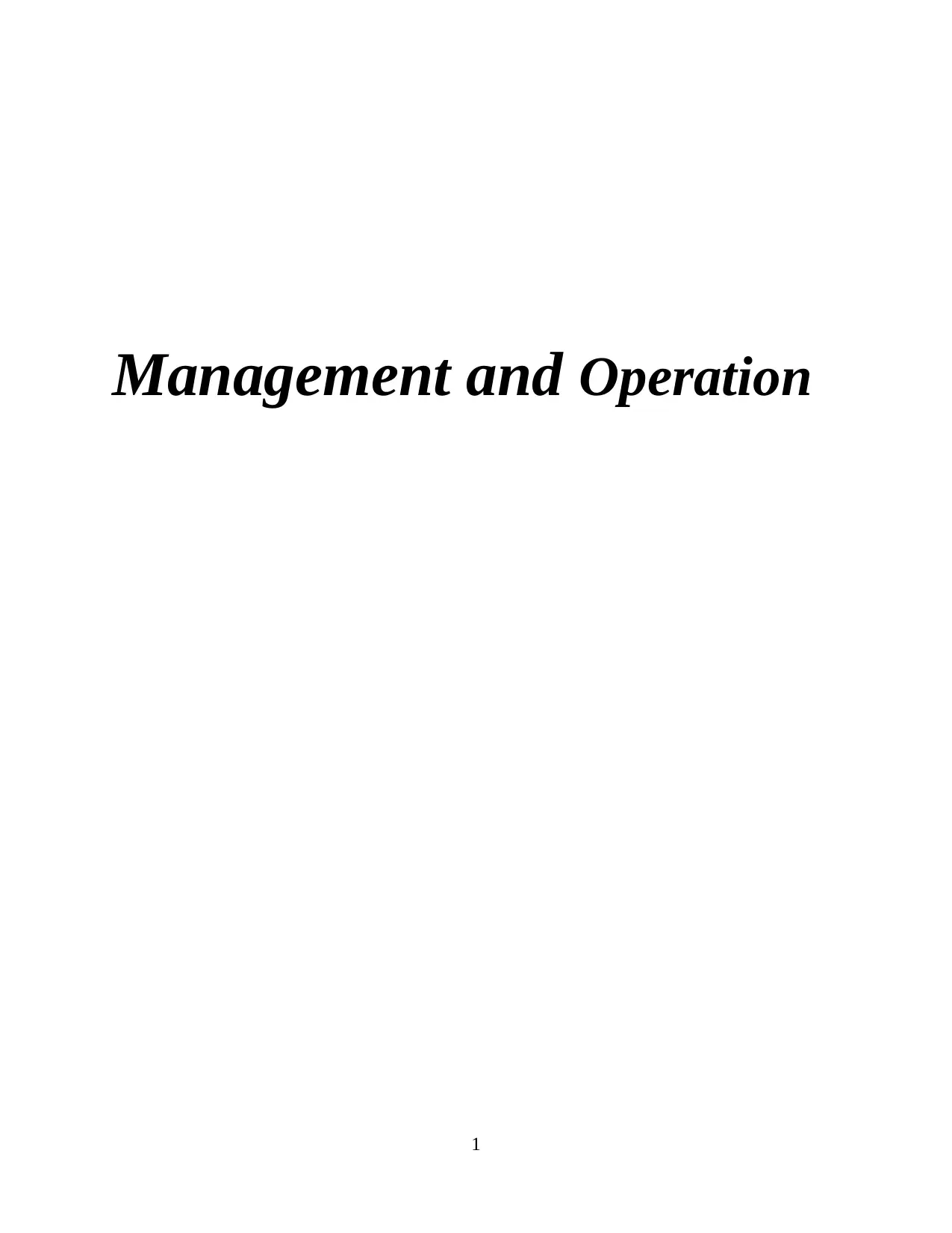
Management and Operation
1
1
Paraphrase This Document
Need a fresh take? Get an instant paraphrase of this document with our AI Paraphraser
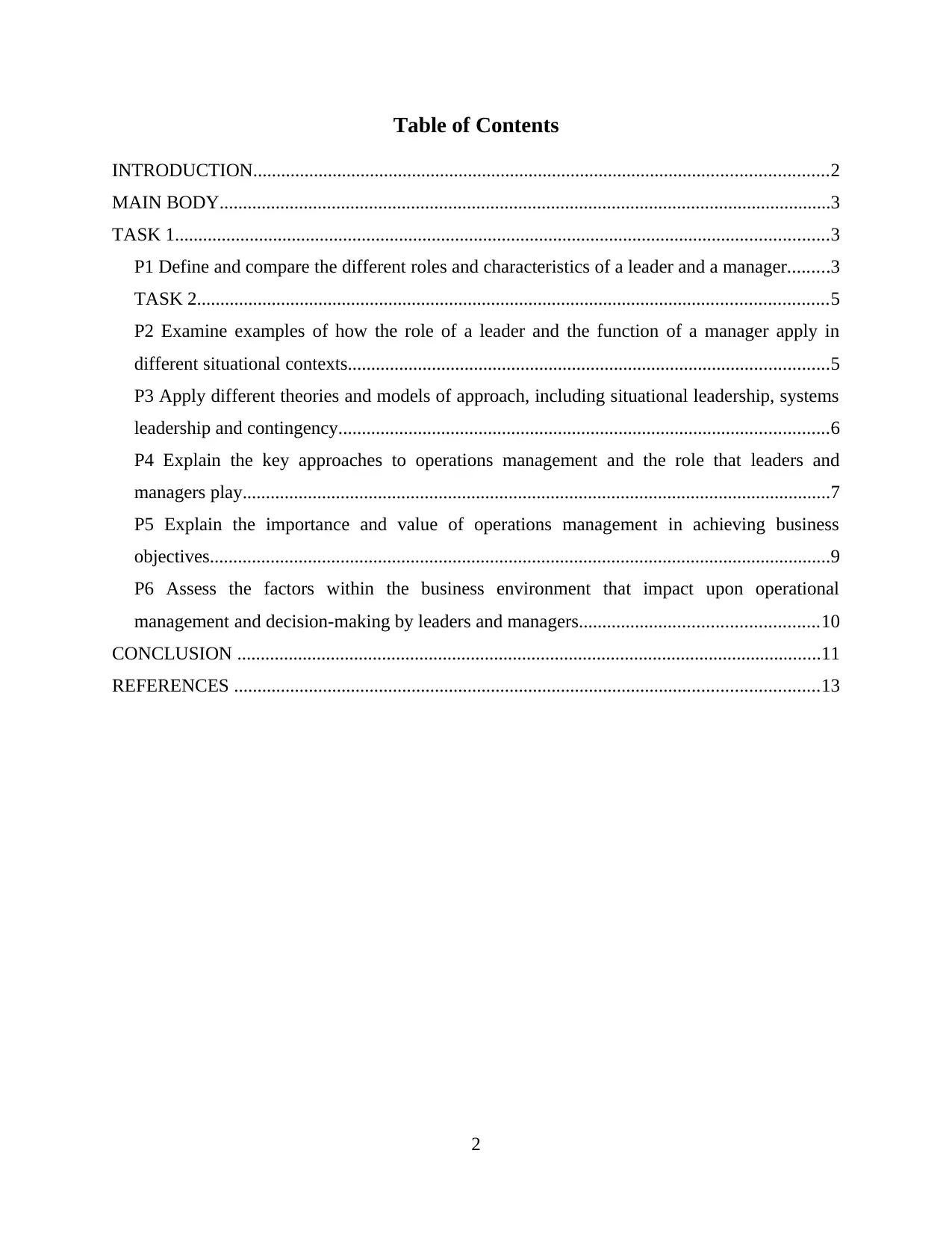
Table of Contents
INTRODUCTION...........................................................................................................................2
MAIN BODY...................................................................................................................................3
TASK 1............................................................................................................................................3
P1 Define and compare the different roles and characteristics of a leader and a manager.........3
TASK 2.......................................................................................................................................5
P2 Examine examples of how the role of a leader and the function of a manager apply in
different situational contexts.......................................................................................................5
P3 Apply different theories and models of approach, including situational leadership, systems
leadership and contingency.........................................................................................................6
P4 Explain the key approaches to operations management and the role that leaders and
managers play..............................................................................................................................7
P5 Explain the importance and value of operations management in achieving business
objectives.....................................................................................................................................9
P6 Assess the factors within the business environment that impact upon operational
management and decision-making by leaders and managers...................................................10
CONCLUSION .............................................................................................................................11
REFERENCES .............................................................................................................................13
2
INTRODUCTION...........................................................................................................................2
MAIN BODY...................................................................................................................................3
TASK 1............................................................................................................................................3
P1 Define and compare the different roles and characteristics of a leader and a manager.........3
TASK 2.......................................................................................................................................5
P2 Examine examples of how the role of a leader and the function of a manager apply in
different situational contexts.......................................................................................................5
P3 Apply different theories and models of approach, including situational leadership, systems
leadership and contingency.........................................................................................................6
P4 Explain the key approaches to operations management and the role that leaders and
managers play..............................................................................................................................7
P5 Explain the importance and value of operations management in achieving business
objectives.....................................................................................................................................9
P6 Assess the factors within the business environment that impact upon operational
management and decision-making by leaders and managers...................................................10
CONCLUSION .............................................................................................................................11
REFERENCES .............................................................................................................................13
2
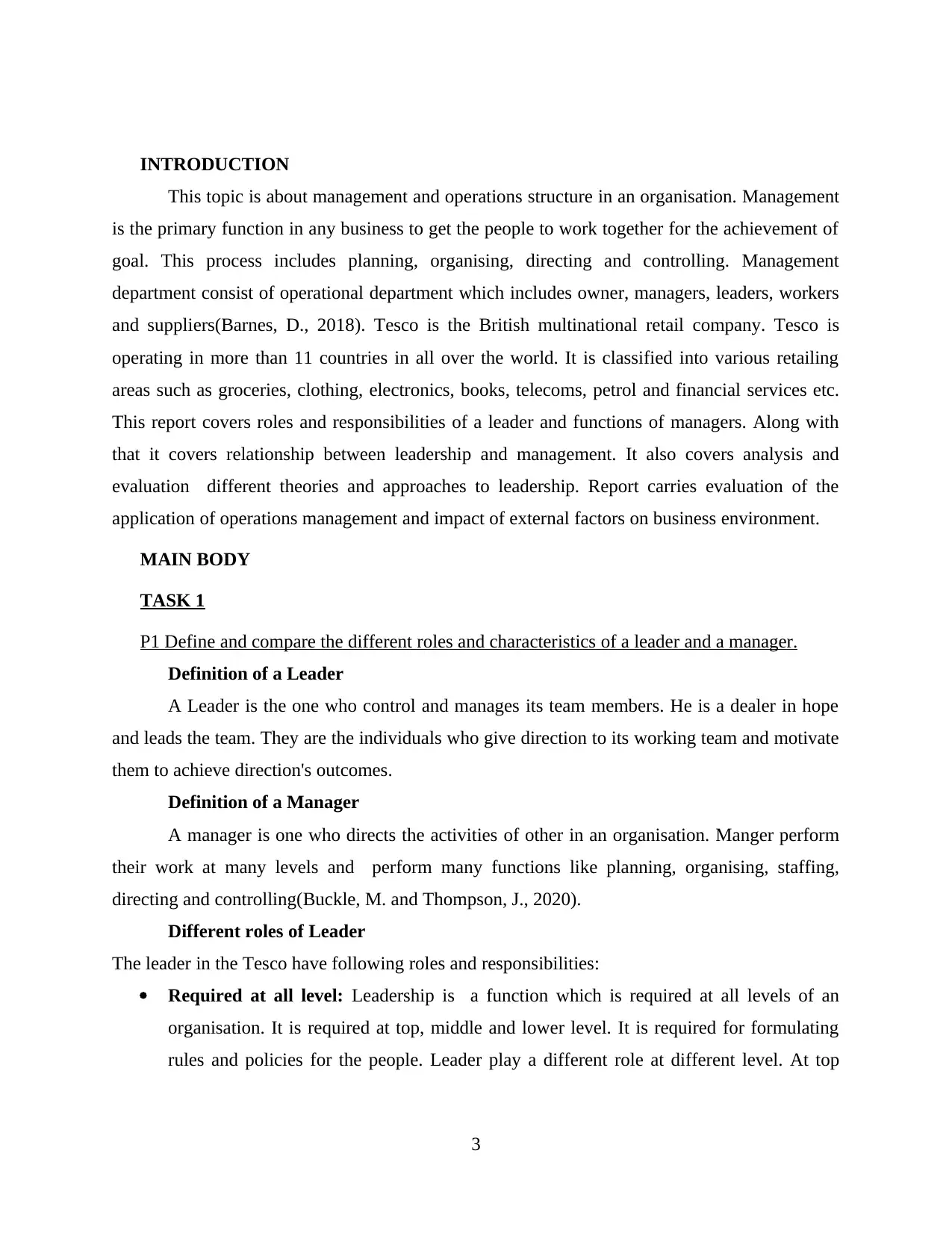
INTRODUCTION
This topic is about management and operations structure in an organisation. Management
is the primary function in any business to get the people to work together for the achievement of
goal. This process includes planning, organising, directing and controlling. Management
department consist of operational department which includes owner, managers, leaders, workers
and suppliers(Barnes, D., 2018). Tesco is the British multinational retail company. Tesco is
operating in more than 11 countries in all over the world. It is classified into various retailing
areas such as groceries, clothing, electronics, books, telecoms, petrol and financial services etc.
This report covers roles and responsibilities of a leader and functions of managers. Along with
that it covers relationship between leadership and management. It also covers analysis and
evaluation different theories and approaches to leadership. Report carries evaluation of the
application of operations management and impact of external factors on business environment.
MAIN BODY
TASK 1
P1 Define and compare the different roles and characteristics of a leader and a manager.
Definition of a Leader
A Leader is the one who control and manages its team members. He is a dealer in hope
and leads the team. They are the individuals who give direction to its working team and motivate
them to achieve direction's outcomes.
Definition of a Manager
A manager is one who directs the activities of other in an organisation. Manger perform
their work at many levels and perform many functions like planning, organising, staffing,
directing and controlling(Buckle, M. and Thompson, J., 2020).
Different roles of Leader
The leader in the Tesco have following roles and responsibilities:
Required at all level: Leadership is a function which is required at all levels of an
organisation. It is required at top, middle and lower level. It is required for formulating
rules and policies for the people. Leader play a different role at different level. At top
3
This topic is about management and operations structure in an organisation. Management
is the primary function in any business to get the people to work together for the achievement of
goal. This process includes planning, organising, directing and controlling. Management
department consist of operational department which includes owner, managers, leaders, workers
and suppliers(Barnes, D., 2018). Tesco is the British multinational retail company. Tesco is
operating in more than 11 countries in all over the world. It is classified into various retailing
areas such as groceries, clothing, electronics, books, telecoms, petrol and financial services etc.
This report covers roles and responsibilities of a leader and functions of managers. Along with
that it covers relationship between leadership and management. It also covers analysis and
evaluation different theories and approaches to leadership. Report carries evaluation of the
application of operations management and impact of external factors on business environment.
MAIN BODY
TASK 1
P1 Define and compare the different roles and characteristics of a leader and a manager.
Definition of a Leader
A Leader is the one who control and manages its team members. He is a dealer in hope
and leads the team. They are the individuals who give direction to its working team and motivate
them to achieve direction's outcomes.
Definition of a Manager
A manager is one who directs the activities of other in an organisation. Manger perform
their work at many levels and perform many functions like planning, organising, staffing,
directing and controlling(Buckle, M. and Thompson, J., 2020).
Different roles of Leader
The leader in the Tesco have following roles and responsibilities:
Required at all level: Leadership is a function which is required at all levels of an
organisation. It is required at top, middle and lower level. It is required for formulating
rules and policies for the people. Leader play a different role at different level. At top
3
⊘ This is a preview!⊘
Do you want full access?
Subscribe today to unlock all pages.

Trusted by 1+ million students worldwide
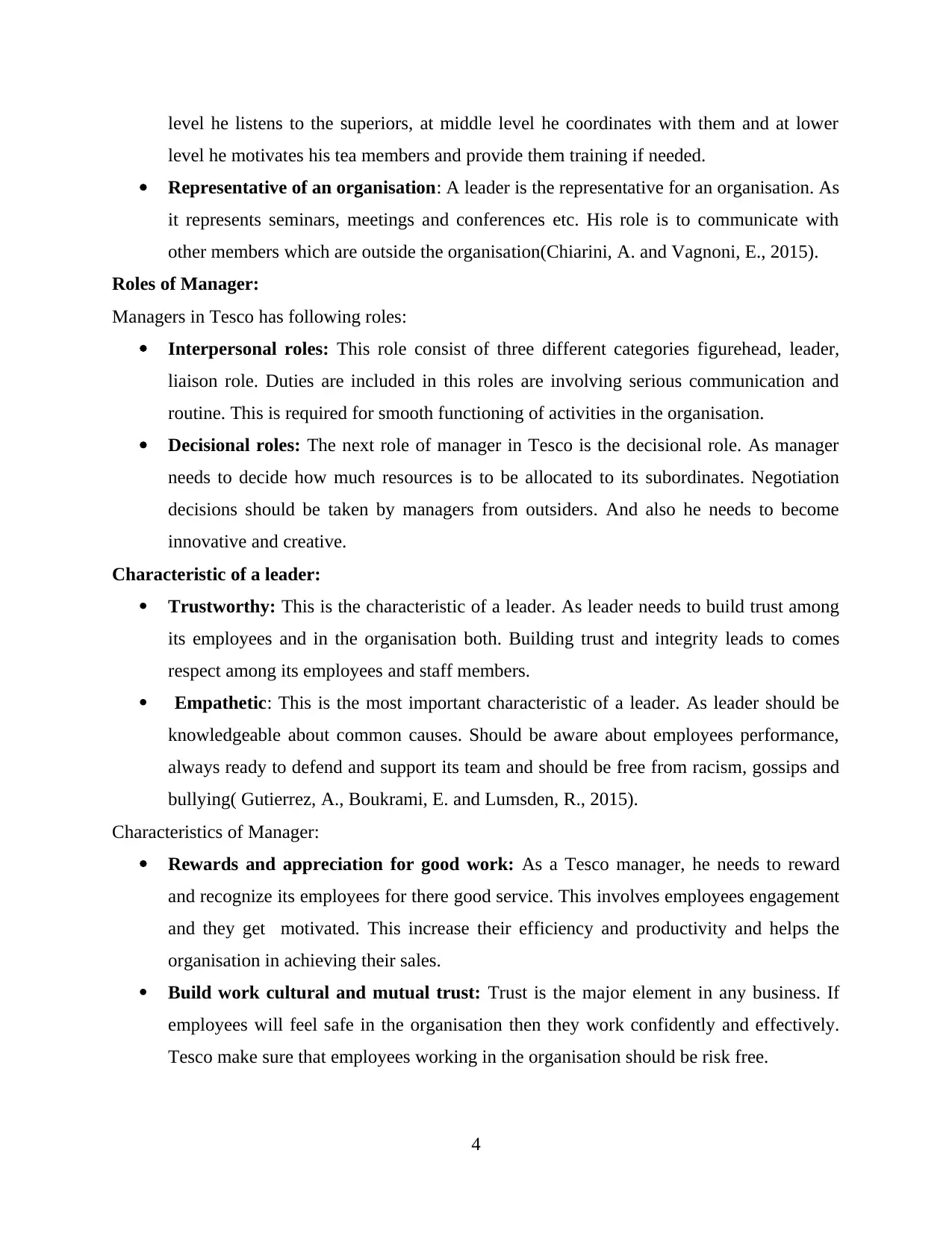
level he listens to the superiors, at middle level he coordinates with them and at lower
level he motivates his tea members and provide them training if needed.
Representative of an organisation: A leader is the representative for an organisation. As
it represents seminars, meetings and conferences etc. His role is to communicate with
other members which are outside the organisation(Chiarini, A. and Vagnoni, E., 2015).
Roles of Manager:
Managers in Tesco has following roles:
Interpersonal roles: This role consist of three different categories figurehead, leader,
liaison role. Duties are included in this roles are involving serious communication and
routine. This is required for smooth functioning of activities in the organisation.
Decisional roles: The next role of manager in Tesco is the decisional role. As manager
needs to decide how much resources is to be allocated to its subordinates. Negotiation
decisions should be taken by managers from outsiders. And also he needs to become
innovative and creative.
Characteristic of a leader:
Trustworthy: This is the characteristic of a leader. As leader needs to build trust among
its employees and in the organisation both. Building trust and integrity leads to comes
respect among its employees and staff members.
Empathetic: This is the most important characteristic of a leader. As leader should be
knowledgeable about common causes. Should be aware about employees performance,
always ready to defend and support its team and should be free from racism, gossips and
bullying( Gutierrez, A., Boukrami, E. and Lumsden, R., 2015).
Characteristics of Manager:
Rewards and appreciation for good work: As a Tesco manager, he needs to reward
and recognize its employees for there good service. This involves employees engagement
and they get motivated. This increase their efficiency and productivity and helps the
organisation in achieving their sales.
Build work cultural and mutual trust: Trust is the major element in any business. If
employees will feel safe in the organisation then they work confidently and effectively.
Tesco make sure that employees working in the organisation should be risk free.
4
level he motivates his tea members and provide them training if needed.
Representative of an organisation: A leader is the representative for an organisation. As
it represents seminars, meetings and conferences etc. His role is to communicate with
other members which are outside the organisation(Chiarini, A. and Vagnoni, E., 2015).
Roles of Manager:
Managers in Tesco has following roles:
Interpersonal roles: This role consist of three different categories figurehead, leader,
liaison role. Duties are included in this roles are involving serious communication and
routine. This is required for smooth functioning of activities in the organisation.
Decisional roles: The next role of manager in Tesco is the decisional role. As manager
needs to decide how much resources is to be allocated to its subordinates. Negotiation
decisions should be taken by managers from outsiders. And also he needs to become
innovative and creative.
Characteristic of a leader:
Trustworthy: This is the characteristic of a leader. As leader needs to build trust among
its employees and in the organisation both. Building trust and integrity leads to comes
respect among its employees and staff members.
Empathetic: This is the most important characteristic of a leader. As leader should be
knowledgeable about common causes. Should be aware about employees performance,
always ready to defend and support its team and should be free from racism, gossips and
bullying( Gutierrez, A., Boukrami, E. and Lumsden, R., 2015).
Characteristics of Manager:
Rewards and appreciation for good work: As a Tesco manager, he needs to reward
and recognize its employees for there good service. This involves employees engagement
and they get motivated. This increase their efficiency and productivity and helps the
organisation in achieving their sales.
Build work cultural and mutual trust: Trust is the major element in any business. If
employees will feel safe in the organisation then they work confidently and effectively.
Tesco make sure that employees working in the organisation should be risk free.
4
Paraphrase This Document
Need a fresh take? Get an instant paraphrase of this document with our AI Paraphraser
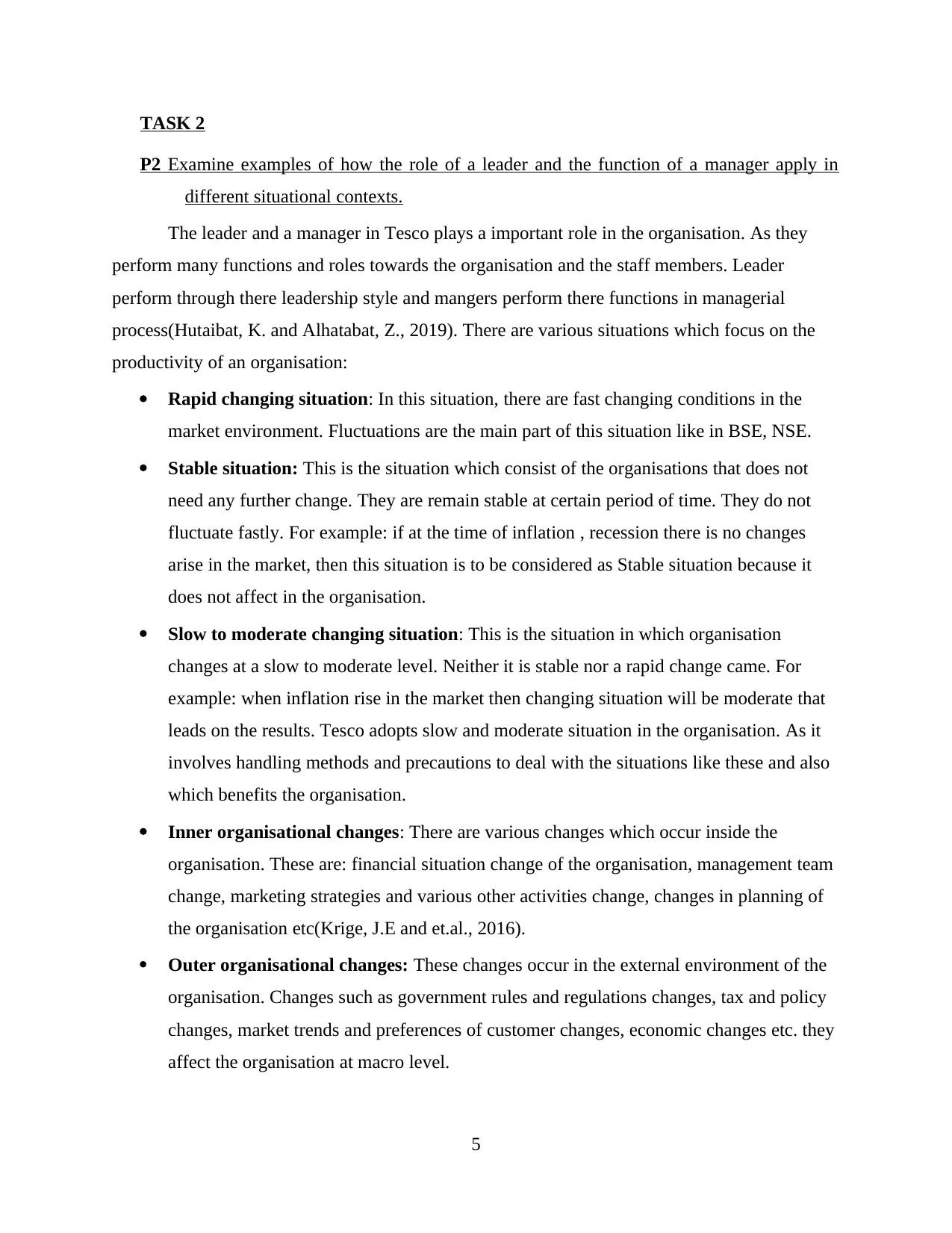
TASK 2
P2 Examine examples of how the role of a leader and the function of a manager apply in
different situational contexts.
The leader and a manager in Tesco plays a important role in the organisation. As they
perform many functions and roles towards the organisation and the staff members. Leader
perform through there leadership style and mangers perform there functions in managerial
process(Hutaibat, K. and Alhatabat, Z., 2019). There are various situations which focus on the
productivity of an organisation:
Rapid changing situation: In this situation, there are fast changing conditions in the
market environment. Fluctuations are the main part of this situation like in BSE, NSE.
Stable situation: This is the situation which consist of the organisations that does not
need any further change. They are remain stable at certain period of time. They do not
fluctuate fastly. For example: if at the time of inflation , recession there is no changes
arise in the market, then this situation is to be considered as Stable situation because it
does not affect in the organisation.
Slow to moderate changing situation: This is the situation in which organisation
changes at a slow to moderate level. Neither it is stable nor a rapid change came. For
example: when inflation rise in the market then changing situation will be moderate that
leads on the results. Tesco adopts slow and moderate situation in the organisation. As it
involves handling methods and precautions to deal with the situations like these and also
which benefits the organisation.
Inner organisational changes: There are various changes which occur inside the
organisation. These are: financial situation change of the organisation, management team
change, marketing strategies and various other activities change, changes in planning of
the organisation etc(Krige, J.E and et.al., 2016).
Outer organisational changes: These changes occur in the external environment of the
organisation. Changes such as government rules and regulations changes, tax and policy
changes, market trends and preferences of customer changes, economic changes etc. they
affect the organisation at macro level.
5
P2 Examine examples of how the role of a leader and the function of a manager apply in
different situational contexts.
The leader and a manager in Tesco plays a important role in the organisation. As they
perform many functions and roles towards the organisation and the staff members. Leader
perform through there leadership style and mangers perform there functions in managerial
process(Hutaibat, K. and Alhatabat, Z., 2019). There are various situations which focus on the
productivity of an organisation:
Rapid changing situation: In this situation, there are fast changing conditions in the
market environment. Fluctuations are the main part of this situation like in BSE, NSE.
Stable situation: This is the situation which consist of the organisations that does not
need any further change. They are remain stable at certain period of time. They do not
fluctuate fastly. For example: if at the time of inflation , recession there is no changes
arise in the market, then this situation is to be considered as Stable situation because it
does not affect in the organisation.
Slow to moderate changing situation: This is the situation in which organisation
changes at a slow to moderate level. Neither it is stable nor a rapid change came. For
example: when inflation rise in the market then changing situation will be moderate that
leads on the results. Tesco adopts slow and moderate situation in the organisation. As it
involves handling methods and precautions to deal with the situations like these and also
which benefits the organisation.
Inner organisational changes: There are various changes which occur inside the
organisation. These are: financial situation change of the organisation, management team
change, marketing strategies and various other activities change, changes in planning of
the organisation etc(Krige, J.E and et.al., 2016).
Outer organisational changes: These changes occur in the external environment of the
organisation. Changes such as government rules and regulations changes, tax and policy
changes, market trends and preferences of customer changes, economic changes etc. they
affect the organisation at macro level.
5
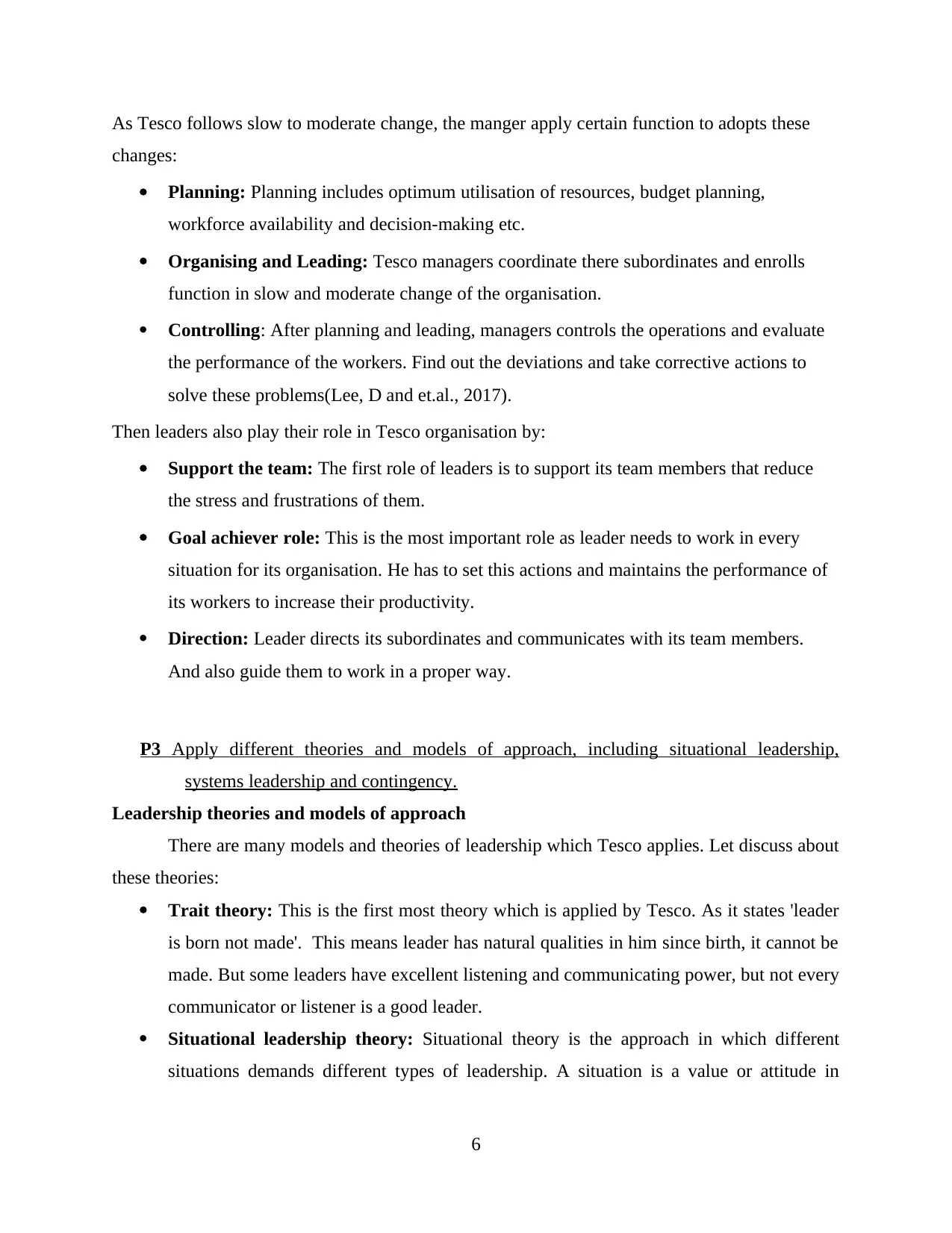
As Tesco follows slow to moderate change, the manger apply certain function to adopts these
changes:
Planning: Planning includes optimum utilisation of resources, budget planning,
workforce availability and decision-making etc.
Organising and Leading: Tesco managers coordinate there subordinates and enrolls
function in slow and moderate change of the organisation.
Controlling: After planning and leading, managers controls the operations and evaluate
the performance of the workers. Find out the deviations and take corrective actions to
solve these problems(Lee, D and et.al., 2017).
Then leaders also play their role in Tesco organisation by:
Support the team: The first role of leaders is to support its team members that reduce
the stress and frustrations of them.
Goal achiever role: This is the most important role as leader needs to work in every
situation for its organisation. He has to set this actions and maintains the performance of
its workers to increase their productivity.
Direction: Leader directs its subordinates and communicates with its team members.
And also guide them to work in a proper way.
P3 Apply different theories and models of approach, including situational leadership,
systems leadership and contingency.
Leadership theories and models of approach
There are many models and theories of leadership which Tesco applies. Let discuss about
these theories:
Trait theory: This is the first most theory which is applied by Tesco. As it states 'leader
is born not made'. This means leader has natural qualities in him since birth, it cannot be
made. But some leaders have excellent listening and communicating power, but not every
communicator or listener is a good leader.
Situational leadership theory: Situational theory is the approach in which different
situations demands different types of leadership. A situation is a value or attitude in
6
changes:
Planning: Planning includes optimum utilisation of resources, budget planning,
workforce availability and decision-making etc.
Organising and Leading: Tesco managers coordinate there subordinates and enrolls
function in slow and moderate change of the organisation.
Controlling: After planning and leading, managers controls the operations and evaluate
the performance of the workers. Find out the deviations and take corrective actions to
solve these problems(Lee, D and et.al., 2017).
Then leaders also play their role in Tesco organisation by:
Support the team: The first role of leaders is to support its team members that reduce
the stress and frustrations of them.
Goal achiever role: This is the most important role as leader needs to work in every
situation for its organisation. He has to set this actions and maintains the performance of
its workers to increase their productivity.
Direction: Leader directs its subordinates and communicates with its team members.
And also guide them to work in a proper way.
P3 Apply different theories and models of approach, including situational leadership,
systems leadership and contingency.
Leadership theories and models of approach
There are many models and theories of leadership which Tesco applies. Let discuss about
these theories:
Trait theory: This is the first most theory which is applied by Tesco. As it states 'leader
is born not made'. This means leader has natural qualities in him since birth, it cannot be
made. But some leaders have excellent listening and communicating power, but not every
communicator or listener is a good leader.
Situational leadership theory: Situational theory is the approach in which different
situations demands different types of leadership. A situation is a value or attitude in
6
⊘ This is a preview!⊘
Do you want full access?
Subscribe today to unlock all pages.

Trusted by 1+ million students worldwide
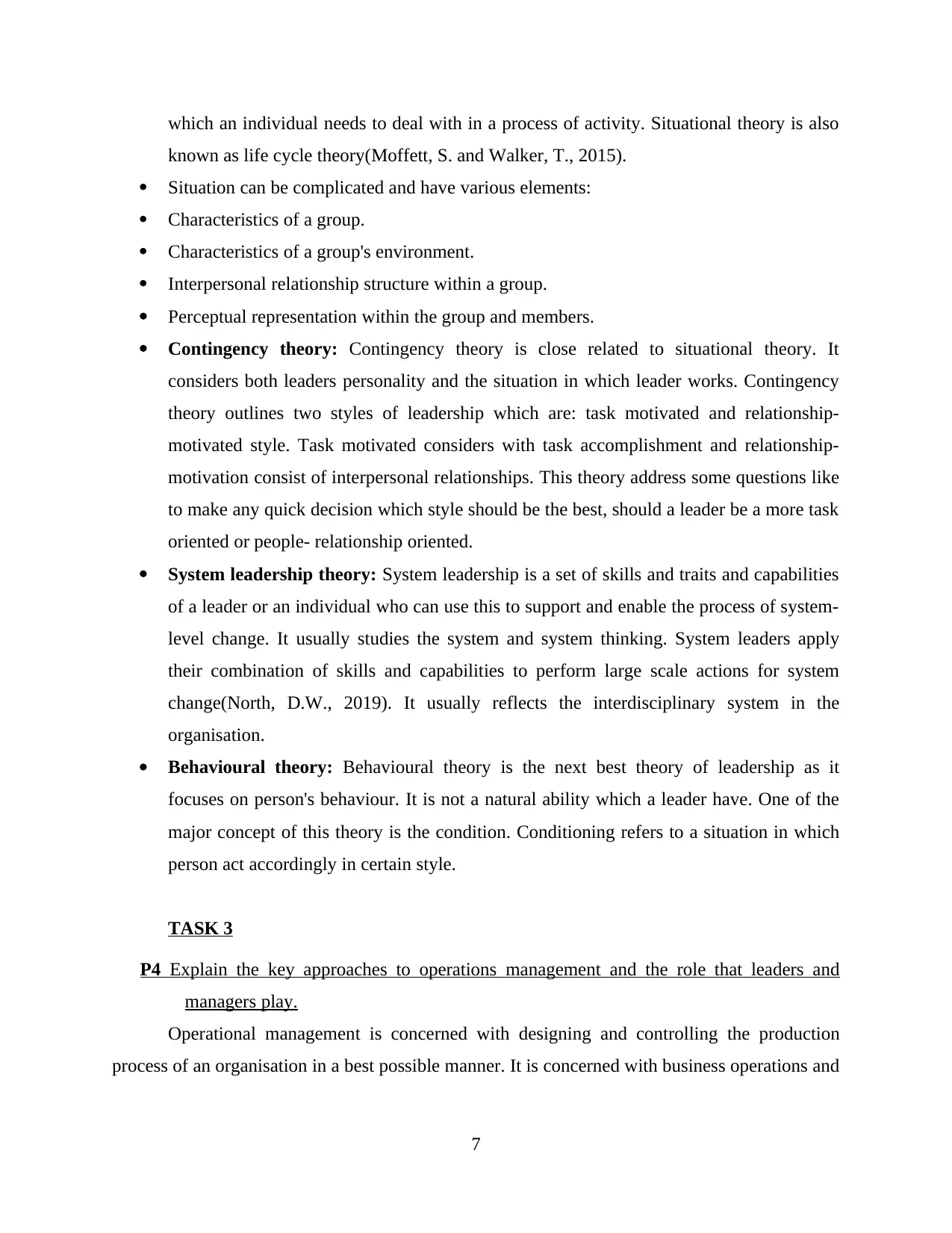
which an individual needs to deal with in a process of activity. Situational theory is also
known as life cycle theory(Moffett, S. and Walker, T., 2015).
Situation can be complicated and have various elements:
Characteristics of a group.
Characteristics of a group's environment.
Interpersonal relationship structure within a group.
Perceptual representation within the group and members.
Contingency theory: Contingency theory is close related to situational theory. It
considers both leaders personality and the situation in which leader works. Contingency
theory outlines two styles of leadership which are: task motivated and relationship-
motivated style. Task motivated considers with task accomplishment and relationship-
motivation consist of interpersonal relationships. This theory address some questions like
to make any quick decision which style should be the best, should a leader be a more task
oriented or people- relationship oriented.
System leadership theory: System leadership is a set of skills and traits and capabilities
of a leader or an individual who can use this to support and enable the process of system-
level change. It usually studies the system and system thinking. System leaders apply
their combination of skills and capabilities to perform large scale actions for system
change(North, D.W., 2019). It usually reflects the interdisciplinary system in the
organisation.
Behavioural theory: Behavioural theory is the next best theory of leadership as it
focuses on person's behaviour. It is not a natural ability which a leader have. One of the
major concept of this theory is the condition. Conditioning refers to a situation in which
person act accordingly in certain style.
TASK 3
P4 Explain the key approaches to operations management and the role that leaders and
managers play.
Operational management is concerned with designing and controlling the production
process of an organisation in a best possible manner. It is concerned with business operations and
7
known as life cycle theory(Moffett, S. and Walker, T., 2015).
Situation can be complicated and have various elements:
Characteristics of a group.
Characteristics of a group's environment.
Interpersonal relationship structure within a group.
Perceptual representation within the group and members.
Contingency theory: Contingency theory is close related to situational theory. It
considers both leaders personality and the situation in which leader works. Contingency
theory outlines two styles of leadership which are: task motivated and relationship-
motivated style. Task motivated considers with task accomplishment and relationship-
motivation consist of interpersonal relationships. This theory address some questions like
to make any quick decision which style should be the best, should a leader be a more task
oriented or people- relationship oriented.
System leadership theory: System leadership is a set of skills and traits and capabilities
of a leader or an individual who can use this to support and enable the process of system-
level change. It usually studies the system and system thinking. System leaders apply
their combination of skills and capabilities to perform large scale actions for system
change(North, D.W., 2019). It usually reflects the interdisciplinary system in the
organisation.
Behavioural theory: Behavioural theory is the next best theory of leadership as it
focuses on person's behaviour. It is not a natural ability which a leader have. One of the
major concept of this theory is the condition. Conditioning refers to a situation in which
person act accordingly in certain style.
TASK 3
P4 Explain the key approaches to operations management and the role that leaders and
managers play.
Operational management is concerned with designing and controlling the production
process of an organisation in a best possible manner. It is concerned with business operations and
7
Paraphrase This Document
Need a fresh take? Get an instant paraphrase of this document with our AI Paraphraser
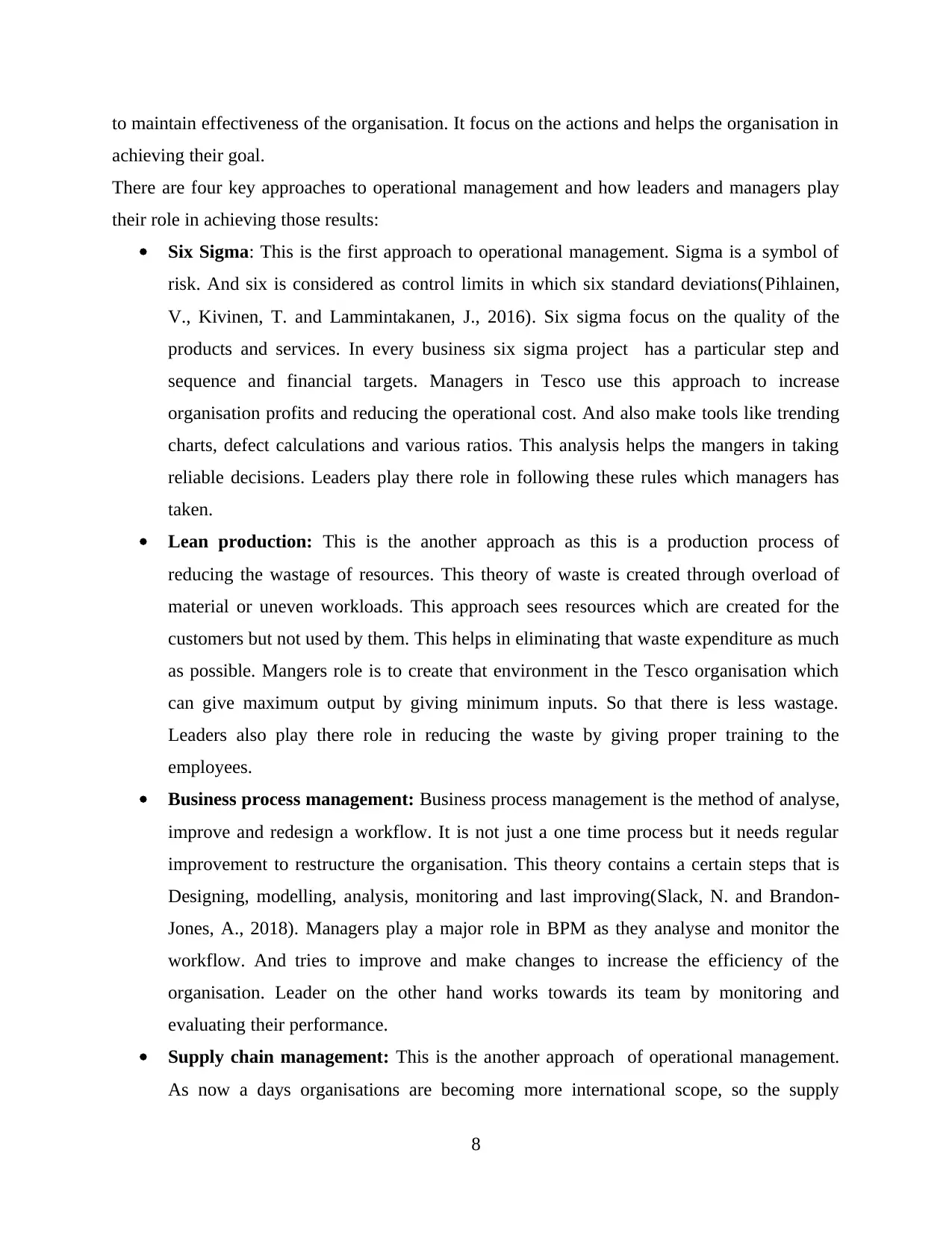
to maintain effectiveness of the organisation. It focus on the actions and helps the organisation in
achieving their goal.
There are four key approaches to operational management and how leaders and managers play
their role in achieving those results:
Six Sigma: This is the first approach to operational management. Sigma is a symbol of
risk. And six is considered as control limits in which six standard deviations(Pihlainen,
V., Kivinen, T. and Lammintakanen, J., 2016). Six sigma focus on the quality of the
products and services. In every business six sigma project has a particular step and
sequence and financial targets. Managers in Tesco use this approach to increase
organisation profits and reducing the operational cost. And also make tools like trending
charts, defect calculations and various ratios. This analysis helps the mangers in taking
reliable decisions. Leaders play there role in following these rules which managers has
taken.
Lean production: This is the another approach as this is a production process of
reducing the wastage of resources. This theory of waste is created through overload of
material or uneven workloads. This approach sees resources which are created for the
customers but not used by them. This helps in eliminating that waste expenditure as much
as possible. Mangers role is to create that environment in the Tesco organisation which
can give maximum output by giving minimum inputs. So that there is less wastage.
Leaders also play there role in reducing the waste by giving proper training to the
employees.
Business process management: Business process management is the method of analyse,
improve and redesign a workflow. It is not just a one time process but it needs regular
improvement to restructure the organisation. This theory contains a certain steps that is
Designing, modelling, analysis, monitoring and last improving(Slack, N. and Brandon-
Jones, A., 2018). Managers play a major role in BPM as they analyse and monitor the
workflow. And tries to improve and make changes to increase the efficiency of the
organisation. Leader on the other hand works towards its team by monitoring and
evaluating their performance.
Supply chain management: This is the another approach of operational management.
As now a days organisations are becoming more international scope, so the supply
8
achieving their goal.
There are four key approaches to operational management and how leaders and managers play
their role in achieving those results:
Six Sigma: This is the first approach to operational management. Sigma is a symbol of
risk. And six is considered as control limits in which six standard deviations(Pihlainen,
V., Kivinen, T. and Lammintakanen, J., 2016). Six sigma focus on the quality of the
products and services. In every business six sigma project has a particular step and
sequence and financial targets. Managers in Tesco use this approach to increase
organisation profits and reducing the operational cost. And also make tools like trending
charts, defect calculations and various ratios. This analysis helps the mangers in taking
reliable decisions. Leaders play there role in following these rules which managers has
taken.
Lean production: This is the another approach as this is a production process of
reducing the wastage of resources. This theory of waste is created through overload of
material or uneven workloads. This approach sees resources which are created for the
customers but not used by them. This helps in eliminating that waste expenditure as much
as possible. Mangers role is to create that environment in the Tesco organisation which
can give maximum output by giving minimum inputs. So that there is less wastage.
Leaders also play there role in reducing the waste by giving proper training to the
employees.
Business process management: Business process management is the method of analyse,
improve and redesign a workflow. It is not just a one time process but it needs regular
improvement to restructure the organisation. This theory contains a certain steps that is
Designing, modelling, analysis, monitoring and last improving(Slack, N. and Brandon-
Jones, A., 2018). Managers play a major role in BPM as they analyse and monitor the
workflow. And tries to improve and make changes to increase the efficiency of the
organisation. Leader on the other hand works towards its team by monitoring and
evaluating their performance.
Supply chain management: This is the another approach of operational management.
As now a days organisations are becoming more international scope, so the supply
8
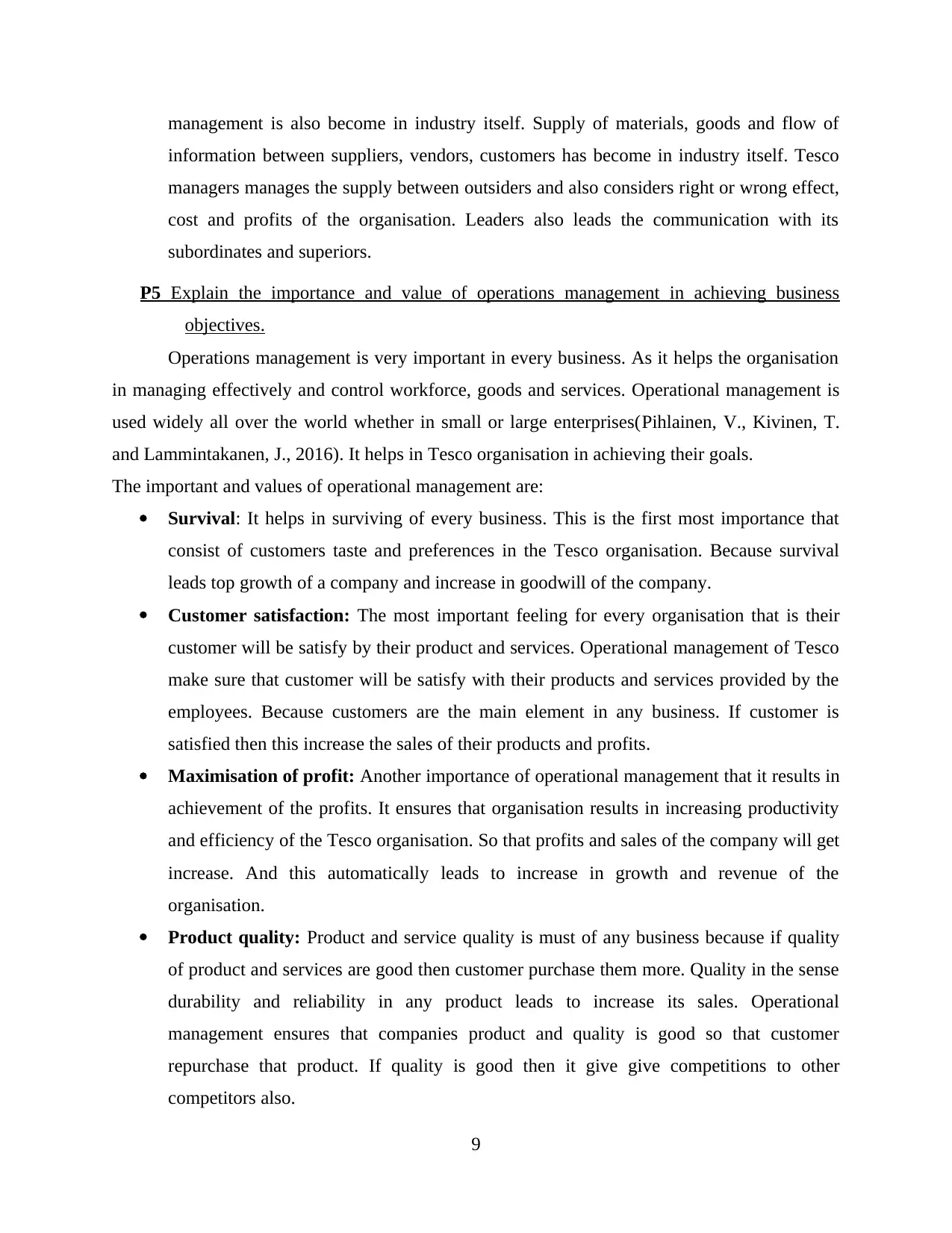
management is also become in industry itself. Supply of materials, goods and flow of
information between suppliers, vendors, customers has become in industry itself. Tesco
managers manages the supply between outsiders and also considers right or wrong effect,
cost and profits of the organisation. Leaders also leads the communication with its
subordinates and superiors.
P5 Explain the importance and value of operations management in achieving business
objectives.
Operations management is very important in every business. As it helps the organisation
in managing effectively and control workforce, goods and services. Operational management is
used widely all over the world whether in small or large enterprises(Pihlainen, V., Kivinen, T.
and Lammintakanen, J., 2016). It helps in Tesco organisation in achieving their goals.
The important and values of operational management are:
Survival: It helps in surviving of every business. This is the first most importance that
consist of customers taste and preferences in the Tesco organisation. Because survival
leads top growth of a company and increase in goodwill of the company.
Customer satisfaction: The most important feeling for every organisation that is their
customer will be satisfy by their product and services. Operational management of Tesco
make sure that customer will be satisfy with their products and services provided by the
employees. Because customers are the main element in any business. If customer is
satisfied then this increase the sales of their products and profits.
Maximisation of profit: Another importance of operational management that it results in
achievement of the profits. It ensures that organisation results in increasing productivity
and efficiency of the Tesco organisation. So that profits and sales of the company will get
increase. And this automatically leads to increase in growth and revenue of the
organisation.
Product quality: Product and service quality is must of any business because if quality
of product and services are good then customer purchase them more. Quality in the sense
durability and reliability in any product leads to increase its sales. Operational
management ensures that companies product and quality is good so that customer
repurchase that product. If quality is good then it give give competitions to other
competitors also.
9
information between suppliers, vendors, customers has become in industry itself. Tesco
managers manages the supply between outsiders and also considers right or wrong effect,
cost and profits of the organisation. Leaders also leads the communication with its
subordinates and superiors.
P5 Explain the importance and value of operations management in achieving business
objectives.
Operations management is very important in every business. As it helps the organisation
in managing effectively and control workforce, goods and services. Operational management is
used widely all over the world whether in small or large enterprises(Pihlainen, V., Kivinen, T.
and Lammintakanen, J., 2016). It helps in Tesco organisation in achieving their goals.
The important and values of operational management are:
Survival: It helps in surviving of every business. This is the first most importance that
consist of customers taste and preferences in the Tesco organisation. Because survival
leads top growth of a company and increase in goodwill of the company.
Customer satisfaction: The most important feeling for every organisation that is their
customer will be satisfy by their product and services. Operational management of Tesco
make sure that customer will be satisfy with their products and services provided by the
employees. Because customers are the main element in any business. If customer is
satisfied then this increase the sales of their products and profits.
Maximisation of profit: Another importance of operational management that it results in
achievement of the profits. It ensures that organisation results in increasing productivity
and efficiency of the Tesco organisation. So that profits and sales of the company will get
increase. And this automatically leads to increase in growth and revenue of the
organisation.
Product quality: Product and service quality is must of any business because if quality
of product and services are good then customer purchase them more. Quality in the sense
durability and reliability in any product leads to increase its sales. Operational
management ensures that companies product and quality is good so that customer
repurchase that product. If quality is good then it give give competitions to other
competitors also.
9
⊘ This is a preview!⊘
Do you want full access?
Subscribe today to unlock all pages.

Trusted by 1+ million students worldwide
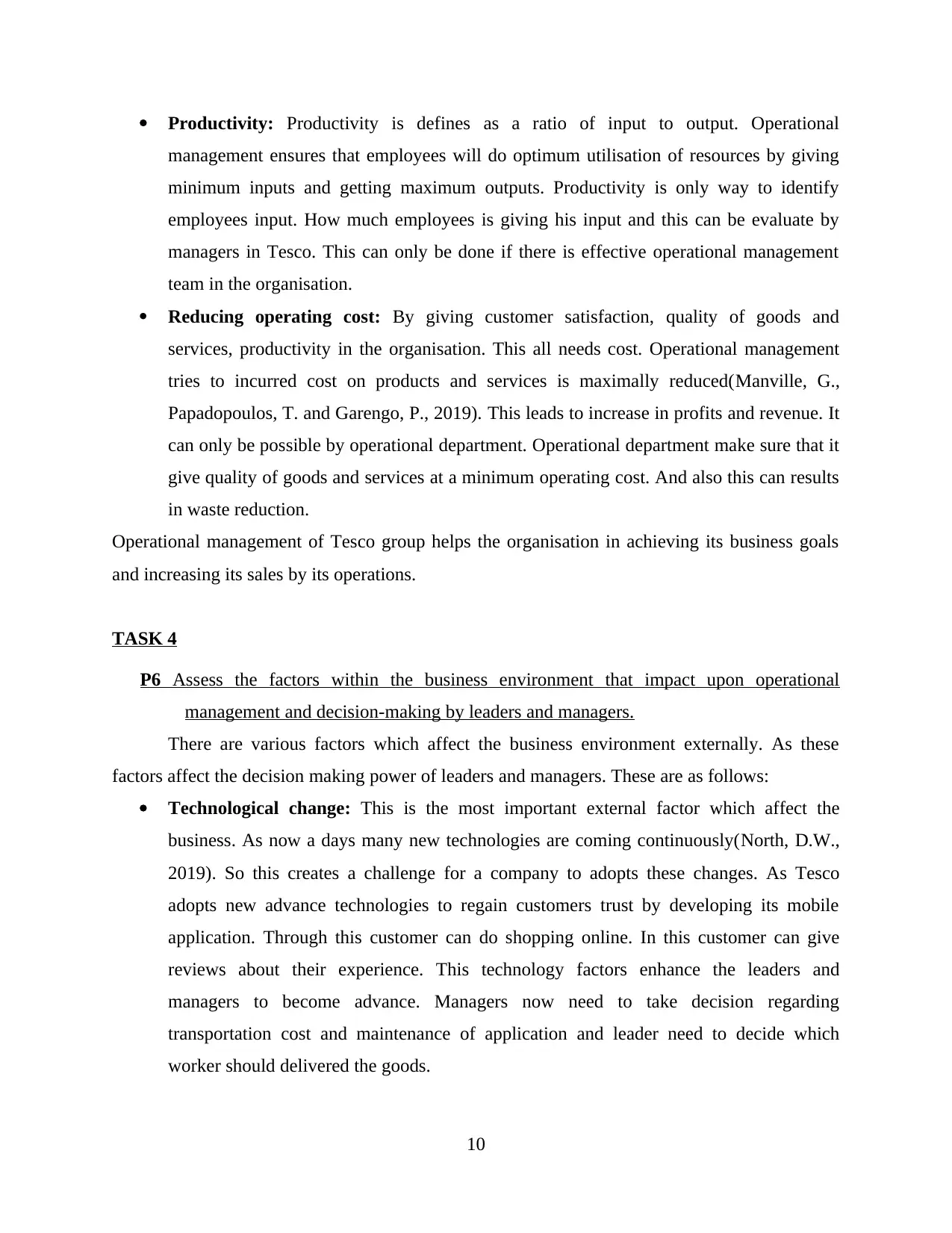
Productivity: Productivity is defines as a ratio of input to output. Operational
management ensures that employees will do optimum utilisation of resources by giving
minimum inputs and getting maximum outputs. Productivity is only way to identify
employees input. How much employees is giving his input and this can be evaluate by
managers in Tesco. This can only be done if there is effective operational management
team in the organisation.
Reducing operating cost: By giving customer satisfaction, quality of goods and
services, productivity in the organisation. This all needs cost. Operational management
tries to incurred cost on products and services is maximally reduced(Manville, G.,
Papadopoulos, T. and Garengo, P., 2019). This leads to increase in profits and revenue. It
can only be possible by operational department. Operational department make sure that it
give quality of goods and services at a minimum operating cost. And also this can results
in waste reduction.
Operational management of Tesco group helps the organisation in achieving its business goals
and increasing its sales by its operations.
TASK 4
P6 Assess the factors within the business environment that impact upon operational
management and decision-making by leaders and managers.
There are various factors which affect the business environment externally. As these
factors affect the decision making power of leaders and managers. These are as follows:
Technological change: This is the most important external factor which affect the
business. As now a days many new technologies are coming continuously(North, D.W.,
2019). So this creates a challenge for a company to adopts these changes. As Tesco
adopts new advance technologies to regain customers trust by developing its mobile
application. Through this customer can do shopping online. In this customer can give
reviews about their experience. This technology factors enhance the leaders and
managers to become advance. Managers now need to take decision regarding
transportation cost and maintenance of application and leader need to decide which
worker should delivered the goods.
10
management ensures that employees will do optimum utilisation of resources by giving
minimum inputs and getting maximum outputs. Productivity is only way to identify
employees input. How much employees is giving his input and this can be evaluate by
managers in Tesco. This can only be done if there is effective operational management
team in the organisation.
Reducing operating cost: By giving customer satisfaction, quality of goods and
services, productivity in the organisation. This all needs cost. Operational management
tries to incurred cost on products and services is maximally reduced(Manville, G.,
Papadopoulos, T. and Garengo, P., 2019). This leads to increase in profits and revenue. It
can only be possible by operational department. Operational department make sure that it
give quality of goods and services at a minimum operating cost. And also this can results
in waste reduction.
Operational management of Tesco group helps the organisation in achieving its business goals
and increasing its sales by its operations.
TASK 4
P6 Assess the factors within the business environment that impact upon operational
management and decision-making by leaders and managers.
There are various factors which affect the business environment externally. As these
factors affect the decision making power of leaders and managers. These are as follows:
Technological change: This is the most important external factor which affect the
business. As now a days many new technologies are coming continuously(North, D.W.,
2019). So this creates a challenge for a company to adopts these changes. As Tesco
adopts new advance technologies to regain customers trust by developing its mobile
application. Through this customer can do shopping online. In this customer can give
reviews about their experience. This technology factors enhance the leaders and
managers to become advance. Managers now need to take decision regarding
transportation cost and maintenance of application and leader need to decide which
worker should delivered the goods.
10
Paraphrase This Document
Need a fresh take? Get an instant paraphrase of this document with our AI Paraphraser
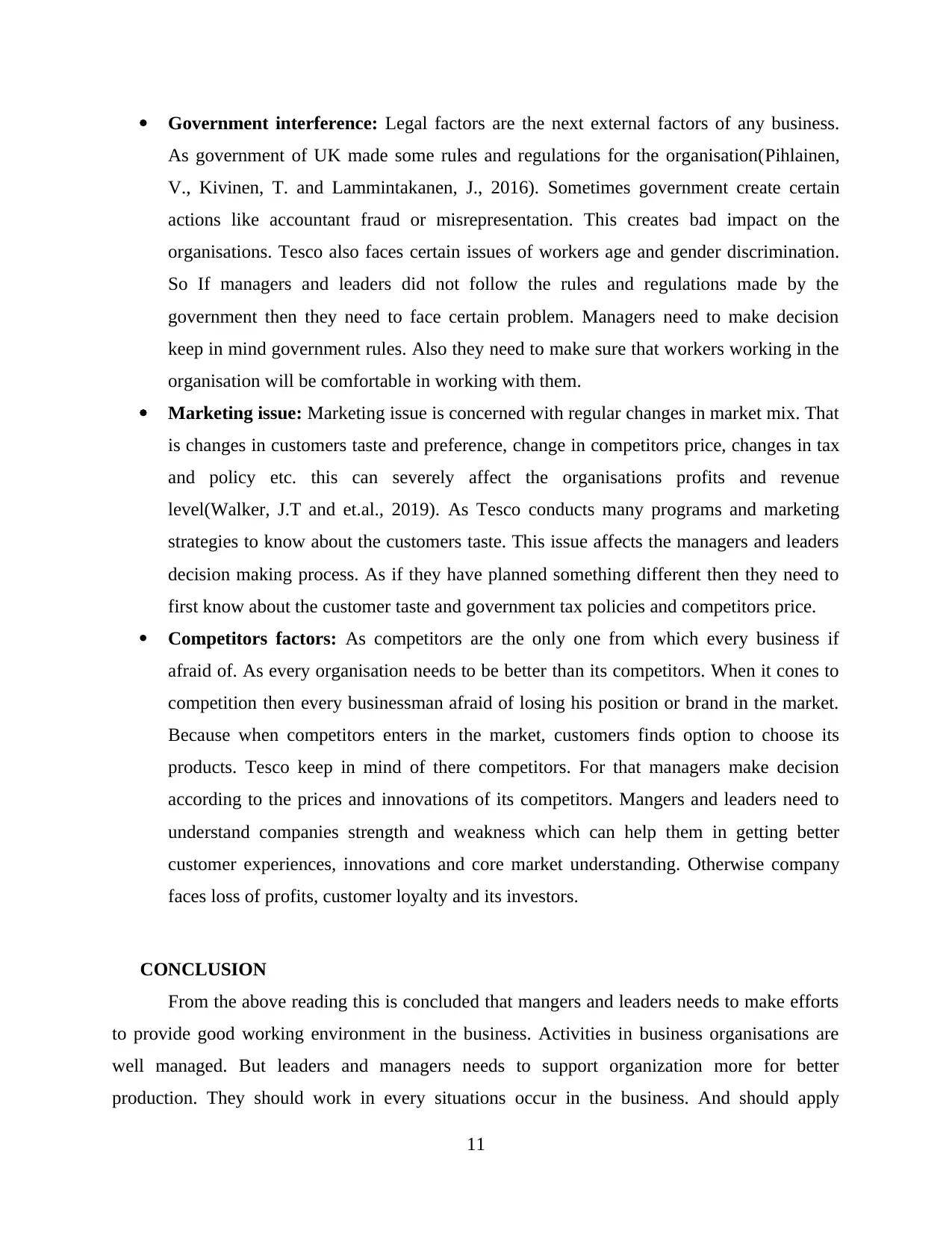
Government interference: Legal factors are the next external factors of any business.
As government of UK made some rules and regulations for the organisation(Pihlainen,
V., Kivinen, T. and Lammintakanen, J., 2016). Sometimes government create certain
actions like accountant fraud or misrepresentation. This creates bad impact on the
organisations. Tesco also faces certain issues of workers age and gender discrimination.
So If managers and leaders did not follow the rules and regulations made by the
government then they need to face certain problem. Managers need to make decision
keep in mind government rules. Also they need to make sure that workers working in the
organisation will be comfortable in working with them.
Marketing issue: Marketing issue is concerned with regular changes in market mix. That
is changes in customers taste and preference, change in competitors price, changes in tax
and policy etc. this can severely affect the organisations profits and revenue
level(Walker, J.T and et.al., 2019). As Tesco conducts many programs and marketing
strategies to know about the customers taste. This issue affects the managers and leaders
decision making process. As if they have planned something different then they need to
first know about the customer taste and government tax policies and competitors price.
Competitors factors: As competitors are the only one from which every business if
afraid of. As every organisation needs to be better than its competitors. When it cones to
competition then every businessman afraid of losing his position or brand in the market.
Because when competitors enters in the market, customers finds option to choose its
products. Tesco keep in mind of there competitors. For that managers make decision
according to the prices and innovations of its competitors. Mangers and leaders need to
understand companies strength and weakness which can help them in getting better
customer experiences, innovations and core market understanding. Otherwise company
faces loss of profits, customer loyalty and its investors.
CONCLUSION
From the above reading this is concluded that mangers and leaders needs to make efforts
to provide good working environment in the business. Activities in business organisations are
well managed. But leaders and managers needs to support organization more for better
production. They should work in every situations occur in the business. And should apply
11
As government of UK made some rules and regulations for the organisation(Pihlainen,
V., Kivinen, T. and Lammintakanen, J., 2016). Sometimes government create certain
actions like accountant fraud or misrepresentation. This creates bad impact on the
organisations. Tesco also faces certain issues of workers age and gender discrimination.
So If managers and leaders did not follow the rules and regulations made by the
government then they need to face certain problem. Managers need to make decision
keep in mind government rules. Also they need to make sure that workers working in the
organisation will be comfortable in working with them.
Marketing issue: Marketing issue is concerned with regular changes in market mix. That
is changes in customers taste and preference, change in competitors price, changes in tax
and policy etc. this can severely affect the organisations profits and revenue
level(Walker, J.T and et.al., 2019). As Tesco conducts many programs and marketing
strategies to know about the customers taste. This issue affects the managers and leaders
decision making process. As if they have planned something different then they need to
first know about the customer taste and government tax policies and competitors price.
Competitors factors: As competitors are the only one from which every business if
afraid of. As every organisation needs to be better than its competitors. When it cones to
competition then every businessman afraid of losing his position or brand in the market.
Because when competitors enters in the market, customers finds option to choose its
products. Tesco keep in mind of there competitors. For that managers make decision
according to the prices and innovations of its competitors. Mangers and leaders need to
understand companies strength and weakness which can help them in getting better
customer experiences, innovations and core market understanding. Otherwise company
faces loss of profits, customer loyalty and its investors.
CONCLUSION
From the above reading this is concluded that mangers and leaders needs to make efforts
to provide good working environment in the business. Activities in business organisations are
well managed. But leaders and managers needs to support organization more for better
production. They should work in every situations occur in the business. And should apply
11
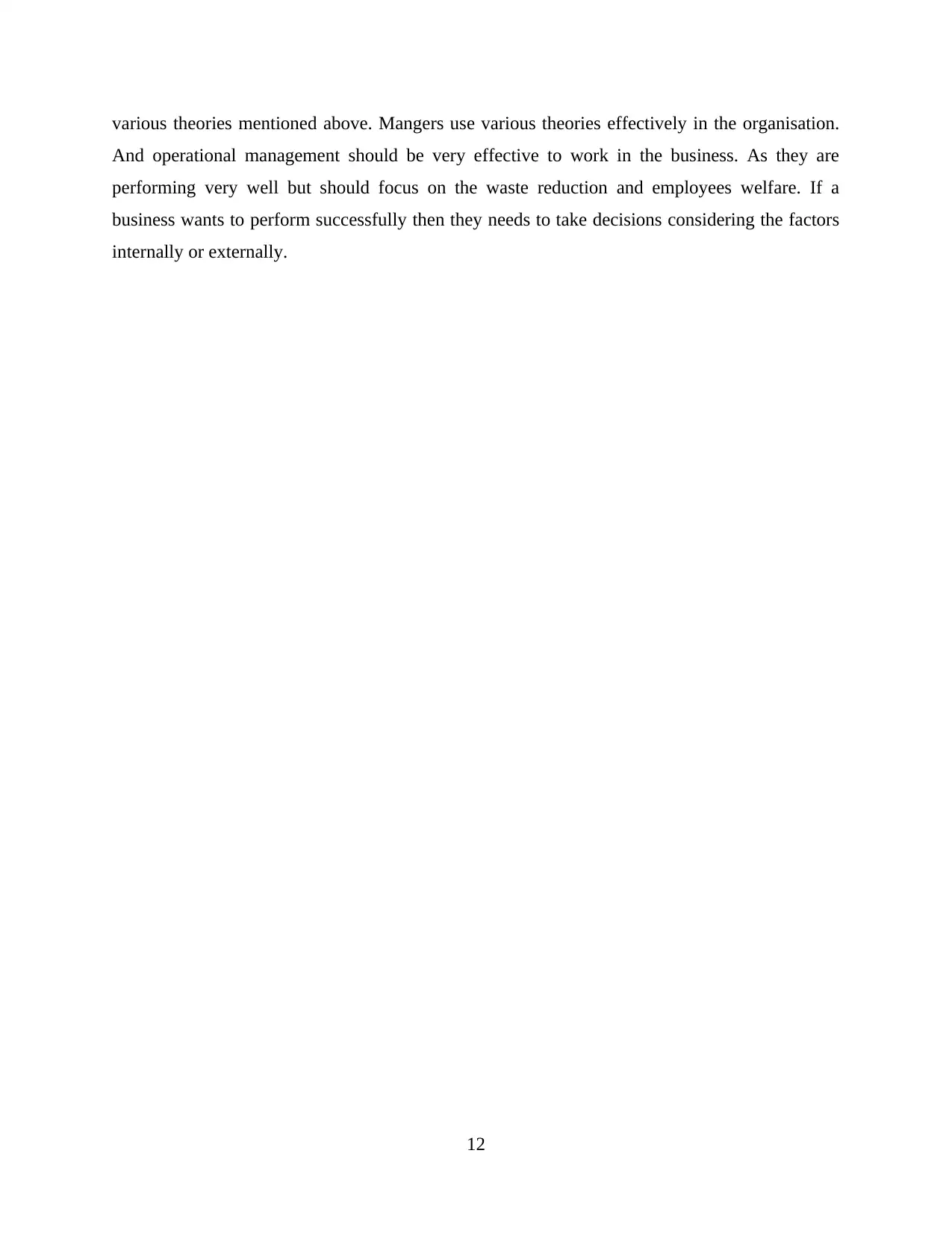
various theories mentioned above. Mangers use various theories effectively in the organisation.
And operational management should be very effective to work in the business. As they are
performing very well but should focus on the waste reduction and employees welfare. If a
business wants to perform successfully then they needs to take decisions considering the factors
internally or externally.
12
And operational management should be very effective to work in the business. As they are
performing very well but should focus on the waste reduction and employees welfare. If a
business wants to perform successfully then they needs to take decisions considering the factors
internally or externally.
12
⊘ This is a preview!⊘
Do you want full access?
Subscribe today to unlock all pages.

Trusted by 1+ million students worldwide
1 out of 13
Related Documents
Your All-in-One AI-Powered Toolkit for Academic Success.
+13062052269
info@desklib.com
Available 24*7 on WhatsApp / Email
![[object Object]](/_next/static/media/star-bottom.7253800d.svg)
Unlock your academic potential
Copyright © 2020–2025 A2Z Services. All Rights Reserved. Developed and managed by ZUCOL.





